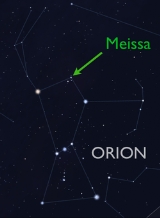
Lambda Orionis
Encyclopedia
Lambda Orionis (λ Ori, λ Orionis) is a star
in the constellation
Orion
. It has the traditional names Meissa or Heka. "Meissa" derives from the Arabic "Al-Maisan" which means "The Shining One". This term was used for Gamma Gemini (Alhena), but was somehow also mistakenly applied to λ Orionis and the name stuck. The original Arabic name for this star, "Al Hakah", the source for "Heka", refere to the Arabic lunar mansion include this star and the both of φ Ori
(Al Haḳʽah, "a White Spot").
In Chinese
, , meaning Turtle Beak
(asterism), refers to an asterism consisting of λ Orionis and both of φ Ori
Consequently, λ Orionis itself is known as
Meissa is a blue spectral type O
giant star
and is part of the Collinder 69
star cluster. It has an apparent visible magnitude
3.39.
Meissa is actually a binary star
system. The fainter star is of magnitude 6 and is 4.4 seconds of arc away from the brighter. It is a hot blue-white dwarf
of spectral type B0.5 V.
Star
A star is a massive, luminous sphere of plasma held together by gravity. At the end of its lifetime, a star can also contain a proportion of degenerate matter. The nearest star to Earth is the Sun, which is the source of most of the energy on Earth...
in the constellation
Constellation
In modern astronomy, a constellation is an internationally defined area of the celestial sphere. These areas are grouped around asterisms, patterns formed by prominent stars within apparent proximity to one another on Earth's night sky....
Orion
Orion (constellation)
Orion, often referred to as The Hunter, is a prominent constellation located on the celestial equator and visible throughout the world. It is one of the most conspicuous, and most recognizable constellations in the night sky...
. It has the traditional names Meissa or Heka. "Meissa" derives from the Arabic "Al-Maisan" which means "The Shining One". This term was used for Gamma Gemini (Alhena), but was somehow also mistakenly applied to λ Orionis and the name stuck. The original Arabic name for this star, "Al Hakah", the source for "Heka", refere to the Arabic lunar mansion include this star and the both of φ Ori
Phi Orionis
The Bayer designation Phi Orionis is shared by two star systems, φ¹ Orionis and φ² Orionis, in the constellation Orion. The two stars are separated by approximately 0.71° in the sky.-φ¹ Orionis:...
(Al Haḳʽah, "a White Spot").
In Chinese
Chinese language
The Chinese language is a language or language family consisting of varieties which are mutually intelligible to varying degrees. Originally the indigenous languages spoken by the Han Chinese in China, it forms one of the branches of Sino-Tibetan family of languages...
, , meaning Turtle Beak
Turtle Beak (Chinese constellation)
The Turtle Beak mansion is one of the Twenty-eight mansions of the Chinese constellations. It is one of the western mansions of the White Tiger.-Asterisms:...
(asterism), refers to an asterism consisting of λ Orionis and both of φ Ori
Phi Orionis
The Bayer designation Phi Orionis is shared by two star systems, φ¹ Orionis and φ² Orionis, in the constellation Orion. The two stars are separated by approximately 0.71° in the sky.-φ¹ Orionis:...
Consequently, λ Orionis itself is known as
Meissa is a blue spectral type O
Stellar classification
In astronomy, stellar classification is a classification of stars based on their spectral characteristics. The spectral class of a star is a designated class of a star describing the ionization of its chromosphere, what atomic excitations are most prominent in the light, giving an objective measure...
giant star
Giant star
A giant star is a star with substantially larger radius and luminosity than a main sequence star of the same surface temperature. Typically, giant stars have radii between 10 and 100 solar radii and luminosities between 10 and 1,000 times that of the Sun. Stars still more luminous than giants are...
and is part of the Collinder 69
Collinder 69
Collinder 69 is a star cluster located north-west of the star Betelgeuse in the constellation of Orion. Included within the cluster is a double star named Meissa. Along with the rest of Orion, it can only be viewed in the winter...
star cluster. It has an apparent visible magnitude
Apparent magnitude
The apparent magnitude of a celestial body is a measure of its brightness as seen by an observer on Earth, adjusted to the value it would have in the absence of the atmosphere...
3.39.
Meissa is actually a binary star
Binary star
A binary star is a star system consisting of two stars orbiting around their common center of mass. The brighter star is called the primary and the other is its companion star, comes, or secondary...
system. The fainter star is of magnitude 6 and is 4.4 seconds of arc away from the brighter. It is a hot blue-white dwarf
Blue-white dwarf
A B-type main-sequence star is a main-sequence star of spectral type B and luminosity class V. These stars have from 2 to 16 times the mass of the Sun and surface temperatures between 10,000 and 30,000 K. B-type stars are extremely luminous and blue. Their spectra have neutral helium, which are...
of spectral type B0.5 V.

